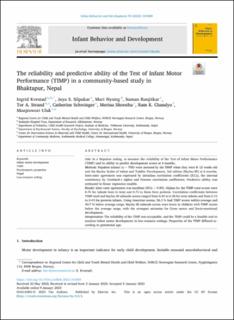| dc.contributor.author | Kvestad, Ingrid | |
| dc.contributor.author | Silpakar, Jaya S. | |
| dc.contributor.author | Hysing, Mari | |
| dc.contributor.author | Ranjitkar, Suman | |
| dc.contributor.author | Strand, Tor Arne | |
| dc.contributor.author | Schwinger, Catherine | |
| dc.contributor.author | Shrestha, Merina | |
| dc.contributor.author | Chandyo, Ram Krishna | |
| dc.contributor.author | Ulak Chandyo, Manjeswori | |
| dc.date.accessioned | 2023-12-20T11:50:40Z | |
| dc.date.available | 2023-12-20T11:50:40Z | |
| dc.date.created | 2023-03-30T14:41:02Z | |
| dc.date.issued | 2023 | |
| dc.identifier.issn | 0163-6383 | |
| dc.identifier.uri | https://hdl.handle.net/11250/3108373 | |
| dc.description.abstract | Aim: In a Nepalese setting, to measure the reliability of the Test of Infant Motor Performance (TIMP) and its ability to predict development scores at 6 months. Methods: Nepalese infants (n = 705) were assessed by the TIMP when they were 8-12 weeks old and the Bayley Scales of Infant and Toddler Development, 3rd edition (Bayley-III) at 6 months. Inter-rater agreement was expressed by intraclass correlation coefficients (ICCs), the internal consistency by Cronbach's alphas and Pearson correlation coefficients. Predictive ability was estimated in linear regression models. Results: Inter-rater agreement was excellent (ICCs > 0.93). Alphas for the TIMP total scores were 0.76 for infants born to term and 0.72 in those born preterm. Correlation coefficients between TIMP total and Bayley-III subscale-scores ranged from 0.05 to 0.28 for term infants and from 0.15 to 0.43 for preterm infants. Using American norms, 56.3 % had TIMP scores within average and 43.7 % below average range. Bayley-III subscale scores were lower in children with TIMP scores below the average range, with the strongest estimates for Gross motor and Socio-emotional development. Interpretation: The reliability of the TIMP was acceptable, and the TIMP could be a feasible tool to monitor infant motor development in low-resource settings. Properties of the TIMP differed according to gestational age. Keywords: Infant motor development; Low-resource setting; Nepal; Psychometric properties; TIMP. | en_US |
| dc.language.iso | eng | en_US |
| dc.publisher | Elsevier | en_US |
| dc.relation.uri | https://www.sciencedirect.com/science/article/pii/S0163638323000012?via%3Dihub | |
| dc.rights | Navngivelse 4.0 Internasjonal | * |
| dc.rights.uri | http://creativecommons.org/licenses/by/4.0/deed.no | * |
| dc.title | The reliability and predictive ability of the Test of Infant Motor Performance (TIMP) in a community-based study in Bhaktapur, Nepal | en_US |
| dc.type | Journal article | en_US |
| dc.type | Peer reviewed | en_US |
| dc.description.version | publishedVersion | en_US |
| dc.rights.holder | Copyright 2023 The Author(s) | en_US |
| dc.source.articlenumber | 101809 | en_US |
| cristin.ispublished | true | |
| cristin.fulltext | original | |
| cristin.qualitycode | 1 | |
| dc.identifier.doi | 10.1016/j.infbeh.2023.101809 | |
| dc.identifier.cristin | 2138574 | |
| dc.source.journal | Infant Behavior and Development | en_US |
| dc.relation.project | Norges forskningsråd: 223269 | en_US |
| dc.identifier.citation | Infant Behavior and Development. 2023, 70, 101809. | en_US |
| dc.source.volume | 70 | en_US |

